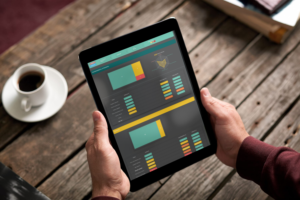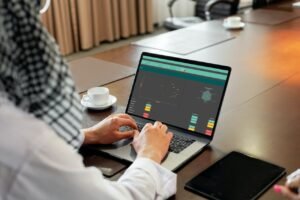In the fast-paced and competitive world of the Food and Beverage industry, having a well-designed menu is crucial for success. But it’s not just about listing dishes and prices; it’s about strategically engineering your menu to maximize profits and enhance customer experience. This process is known as menu engineering, and it’s an essential concept that F&B businesses, whether it’s a restaurant, cafe, or bar, should understand and implement to thrive in today’s competitive market. In today’s digital age, automation is revolutionizing the F&B sector, and leveraging automation for menu engineering can empower F&B professionals to unlock new levels of efficiency, profitability, and customer satisfaction.
Principles of Menu Engineering
Menu engineering is a systematic process that involves analyzing and manipulating various elements of a menu to influence customer behavior and increase sales of high-profit items. The goal is to design a menu that is visually appealing, easy to navigate, and strategica
lly priced to optimize profitability. Menu engineers use data-driven insights and marketing principles to create a menu that entices customers to choose items that are more profitable for the business. There are four key elements to consider in menu engineering:
- Popularity: This refers to how frequently a dish is ordered by customers. Popular dishes are those that are ordered frequently and contribute to a significant portion of a restaurant’s sales.
- Profitability: This refers to the contribution margin of a dish, which is the difference between the selling price and the cost of the ingredients. High-profit dishes are those that have a high contribution margin and generate more profit for the restaurant.
- Placement: The physical location of a dish on the menu plays a crucial role in its sales. Strategic placement can influence customers’ ordering behavior and guide them towards certain dishes.
- Design: The visual design of the menu, including the use of colors, fonts, and graphics, can also impact customers’ perception of the dishes and influence their ordering decisions.
Benefits of Menu Engineering

Source : @WiseFins
Implementing menu engineering techniques can yield several benefits for F&B businesses. Some of the key benefits include:
1. Maximizes Profitability
One of the primary benefits of menu engineering is its ability to boost profitability for F&B operators. Through data-driven analysis and strategic decision-making, menu engineering can identify high-profit items and promote them effectively on the menu. By optimizing their pricing, portion size, and presentation, menu engineering can influence customer behavior and drive sales of these items, resulting in increased profitability.
Example: With the implementation of menu engineering, a restaurant can align the cost of ingredients with the selling price of an item, enabling instant identification of its profit margin. Consequently, a restaurant gains the ability to establish a price strategy that takes into account both the popularity and profitability of each menu item. For instance, a restaurant has identified that the Caesar Salad is popular but falls short in terms of profitability. As a result, the restaurant has the option to make adjustments such as reducing portion size, reviewing the ingredients used for less costly alternatives, slightly increasing the selling price, or replacing the item with a more profitable option.
2. Enhances Customer Experience
A well-designed menu is not only visually appealing but also easy to navigate, providing a positive dining experience for customers. In addition to that, other aspects can be highlighted. For instance, menu engineering ensures that the most popular and profitable dishes are retained on the menu, ensuring that customers can always find their favorite dishes available. This approach allows the restaurant to maintain a loyal customer base while optimizing its profitability. By consistently offering beloved menu items, the establishment can enhance customer satisfaction and build a strong reputation for delivering consistent quality.
Example: After conducting menu engineering analysis, a restaurant discovers that its “Classic Spaghetti Bolognese” is not only a customer favorite but also highly profitable due to the reasonable cost of ingredients. Recognizing the value of maintaining customer satisfaction and maximizing profitability, the restaurant decides to retain the dish on its menu. This consistent availability cultivates a loyal customer base who appreciate the restaurant’s commitment to offering their favorite pasta. As a result, the restaurant experiences increased customer satisfaction. The restaurant can also allocate resources effectively and invest in maintaining the quality of the ingredients used in the dish. This attention to quality further enhances the dining experience. As volumes are high, the restaurant also has the opportunity to discuss ingredients cost with its supplier in order to further increase profitability.
3. Improves Operational Efficiency
Menu engineering involves analyzing sales data and customer preferences, providing valuable insights that can improve operational efficiency for F&B operators. By understanding which items are popular, which ones are not performing well, and how pricing impacts sales, operators can make data-driven decisions to optimize their menu offerings and streamline operations.
Example: A restaurant may analyze sales data and realize that certain menu items are not selling well and have a low-profit margin. Through menu engineering, the restaurant can either revamp or remove these items from the menu, reducing food waste and operational costs. On the other hand, the restaurant can also identify popular items and optimize their pricing or portion size to maximize profitability. This can result in improved operational efficiency, reduced costs, and increased profitability for the business.
4. Supports Branding and Marketing Efforts
A well-designed menu can be a powerful branding and marketing tool for F&B operators. It not only lists the items and prices but also conveys the personality, style, and uniqueness of the establishment. Menu engineering allows operators to showcase their signature dishes, promotions, and special offers, creating a memorable impression on customers and driving sales.
Example: A café that specializes in organic and locally sourced ingredients can use menu engineering techniques to highlight these attributes on the menu. The café can use visual cues like icons or labels to indicate organic or locally sourced items, and incorporate descriptions that emphasize the freshness and sustainability of the ingredients.
Streamlining Menu Engineering with Technology and WiseFins

Source: @WiseFins
1. Automated Real-Time Data Collection
One of the challenges that restaurants often face is the fluctuation of raw material costs. Ingredients that were once affordable and profitable can suddenly become more expensive, impacting the profitability of menu items. With a dynamic costing solution, menu engineering remains accurate and adaptable to these cost fluctuations. WiseFins employs real-time data and analytics to track and update ingredient costs, providing restaurateurs with an accurate picture of the profitability of each menu item. Data is collected automatically, eliminating the requirement for manual data entry, resulting in time savings and a reduced risk of errors.
2. Data-Driven Decision Making
Menu engineering involves analyzing sales data, customer preferences, and other key metrics to make informed decisions about menu design, pricing, and item placement. Automation can streamline the data collection and analysis process, allowing F&B professionals to access real-time data and insights to make data-driven decisions. For instance, with WiseFins, F&B professionals can collect and analyze sales data, such as item popularity, profit margins, and customer preferences, in a more efficient and accurate manner. This data can then be used to identify high-profit items, optimize pricing, portion size, and placement on the menu, and make data-driven decisions on which items to promote or remove from the menu. Automation can enable F&B professionals to quickly and easily analyze complex data, leading to better menu engineering strategies and improved profitability.
3. Pricing Optimization
Pricing is a critical element of menu engineering, as it directly impacts sales and profitability. Automation can assist F&B professionals in optimizing menu prices based on various factors, such as food cost, competition, and customer demand. For example, with the help of WiseFins, F&B professionals can analyze food costs, profit margins, and sales data to determine the optimal pricing for each menu item. They can set pricing rules and parameters, such as desired profit margins or price-to-cost ratios, and the system can automatically calculate and adjust prices accordingly. Automation can also allow F&B professionals to conduct pricing experiments, such as A/B testing, to determine the most effective pricing strategy for their menu items. This can lead to optimized pricing strategies that maximize profitability while remaining competitive in the market.
4. Streamlined Operations and Cost Savings
Automation plays a vital role in streamlining menu engineering operations, offering significant time, effort, and cost savings for F&B professionals. With WiseFins, recipe management becomes centralized, simplifying the process of updating and modifying menus across multiple locations. This eliminates the manual effort required for menu updates, reducing the risk of errors, ensuring consistency in menu offerings and pricing, and saving time. Did you know? The original setup and ongoing updates of a menu engineering Excel sheet generated by F&B professionals typically consume between 10 and 30 hours of work per month.
5. Budgeting and Forecasting
Technology can help F&B professionals create budgets, set financial goals, and forecast sales and expenses. This can assist in strategic menu planning, identifying opportunities for cost savings, and optimizing menu offerings based on budget constraints.
What about the environment and what can we do for our planet?
In today’s world, sustainability has become a key consideration for businesses across various industries. In particular, the food and beverage industry has been increasingly recognizing the importance of sustainable practices. WiseFins has created a sustainable menu engineering system including advanced data analytics capabilities. We utilize sophisticated algorithms to analyze data on ingredients and recipes to identify opportunities for sustainability improvements. It also provides a comprehensive sustainability assessment tool that evaluates the sustainability performance of different menu items as well as recommendations on how to improve the sustainability of the menu, such as suggesting alternatives for high environmental impact ingredients.
Conclusion
The role of technology in menu engineering cannot be overstated for F&B professionals. It serves as a crucial tool that automates data collection, analysis, and reporting, leading to time savings and streamlined operations. With the aid of financial software as WiseFins, F&B professionals can make informed decisions, optimize pricing and costing strategies, and enhance menu offerings, thereby contributing to the success of their F&B operations.
Furthermore, incorporating a commitment to sustainability on menus unlocks numerous advantages for restaurants. Not only does it attract eco-conscious customers, but it also sets the brand apart from competitors. Additionally, showcasing sustainability practices can boost sales, enhance the restaurant’s reputation, and foster customer loyalty. By prioritizing sustainability and communicating it effectively on menus, restaurants can tap into a growing consumer demand for environmentally friendly dining experiences, contributing to their overall success in a competitive market.
